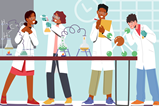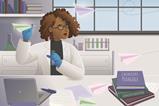Well, if not perfect, certainly more beneficial to students’ understanding of challenging chemistry concepts

Practical work is used extensively in science classrooms at all levels; to increase motivation, develop practical skills, practise being a scientist and learn new concepts. However, research has shown that practical work often has little or no impact on students’ learning of scientific concepts.
In Dom Shibli’s article on how to teach cognitively-confusing chemistry with confidence, he addressed four reasons for pupils encountering difficulties when moving from teacher explanation to independent learning. Apply these four reasons in class to improve the use of practical activities and help with learning scientific concepts.
1. Teacher instruction and explanation are not clear
Pupils are less likely to learn from a practical activity if they are unsure of what they should be focusing on while doing it. As Daniel Willingham, psychologist and author of Why don’t students like school?, said, ‘Memory is the residue of thought’ – so we have to ensure our pupils are thinking about what we want them to think about. Are they focusing on the observations that we want them to? Are they following our instructions correctly? You can get around these problems by using a slow practical or integrated instructions. Both of these strategies will reduce the cognitive load of the practical and allow students to use their limited working memory capacity to think about what we want them to.
2. The subject knowledge is challenging and not yet secure
If students don’t have the required knowledge before carrying out a practical, working memory will quickly become overloaded as they wrestle with the cognitive task of carrying out the practical while also trying to make sense of observations/measurements. Before using a practical activity to teach a scientific concept, ensure pupils have a broad understanding of the concept they need to understand. Pupils can then form a hypothesis based on their knowledge of the concept, and carry out the practical to test this hypothesis. This will help direct students’ focus during the practical.
Tips for a perfect practical
To maximise the learning of a scientific concept using a practical, consider these five things.
- Think carefully about what you want your students to learn from the practical.
- Then, consider how you can minimise the ‘noise’ from the practical so your students focus on the observations/measurements you want them to make, eg using a slow practical or making instructions less cognitively demanding by using integrated instructions.
- Ensure students have sufficient background knowledge of the concept to link their observations/measurements to their prior understanding.
- Make sure the manipulation of unfamiliar equipment will not use up too much working memory. If this is the case, perhaps use a pre-practical activity to help your students develop practical skills, such as learning how to use a burette and bulb pipette before carrying out a titration.
- Consider whether a teacher demonstration may be more appropriate to ensure your students are paying attention and making the right observations. This could dispel the cognitive load issues associated with using unfamiliar equipment.
3. Questions do not reflect the examples in the teacher explanation, or are too hard
In the article about applying cognitive load theory to chemistry teaching, the focus was on moving to answer questions independently, but the same argument could apply when students start to carry out a practical activity independently. You may give a fantastic explanation of the purpose of the practical, ensure pupils have a secure understanding of the learning concept and avoid cognitive overload by using a slow practical and/or integrated instructions, but what if the practical involves manipulating apparatus that the pupils are unfamiliar with? For example, in a titration, can your pupils confidently use a bulb pipette? If a pupil’s working memory is focused on manipulating familiar equipment, then they are likely to focus on the observations/measurements you’d like them to be making.
4. There is a perceived pressure to move from teacher-led to student-based learning before the students are ready
There is a common misconception that pupils will learn better when they discover new concepts by themselves. This may mean you use a practical activity to explore a new concept by discovery learning. In turn, students could then focus on the wrong aspect of the practical and/or misconceptions being consolidated. For example, when carrying out the test for unsaturated hydrocarbons using bromine solution, students may incorrectly focus on the two layers formed when the bromine solution is added to the hydrocarbon, rather than the colour change. This ties in with point 2 – if you ensure students are secure in their knowledge of the addition reactions of alkenes, then they can form a hypothesis before carrying out the practical activity and they will be focused on looking for a colour change. There may even be situations where a teacher-led demonstration is better to direct student attention to the appropriate observations, removing the cognitive load of equipment manipulation.














1 Reader's comment